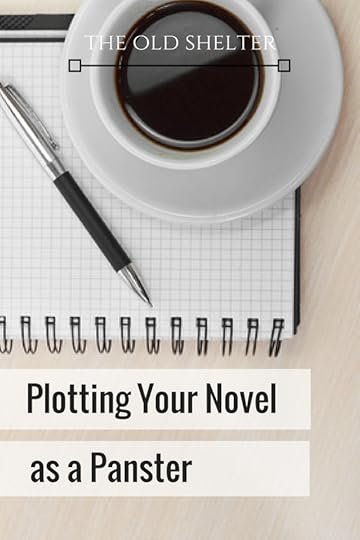Plotting Your Novel as a Pantser
And so, it’s that time of the year again. November. Which means: NaNoWriMo!
I’ve been taking part in NaNo almost every year since 2005 (I just skipped a couple of years), and still every year is different. It’s always a new sensation. But this year even more so.
After five years of being a rebel and revising my project rather than write a new draft, this year I’m back at drafting.
No, I’m not done with Ghost Trilogy. No I’m not giving up on it. But this year I want to work to a completely new project. And no, I won’t talk about it now, that’s matter for a new post.
But a new draft means starting all over again… only in a different place.
When I first drafted Ghost Trilogy during that distant 2010 NaNoWriMo, I knew nothing about novel writing. Seriously. I even started off thinking I wasn’t writing a novel at all, but just a trilogy of novellas (and I hope this is not going to happen again, because I’m once again going for a series of novellas… gulp!). I started off drafting a synopsis, I ended up writing a first draft. I just went with my intuition, take one step at a time, ending up in the middle of the trilogy completely confused and overwhelmed with all the character arcs and the plot threads and an understanding that there was no way I was going to do a good job out of it unless I planned it in a more structured way.
It was a very exciting journey, which I really enjoyed, but a very long one too. Had I been more experienced, Ghost Trilogy might be finished by now.
Still the trilogy has thought me so many things, so I’m going into this new project with a very different mindset. I thought I wasn’t going to just write and see what happens, as I did in 2010. I thought I am a planner, and so I’d plan everything before I started.
Confession: I’m definitely a planner after I’ve written the first draft, but before I write it? I’m an hopeless pantser.
I couldn’t do the job I hoped I’d do before NaNo. There’s no way I’ll have an outline before I start writing. That’s fine, that’s how my creativity works, but still there’s some work that I can do.
Follow me.

The 7 Points Story Structure
I won’t have an outline ready for NaNo, but I’ll have a direction, which is really everything I need. How will I find that direction?
I had heard about the 7 Point Story Structure before, but I considered using it only when I read Hunter Emkay’s post 7 Points Story Structure. This is what the basic structur elooks like:
Hook – This is where the story begins, it’s what your character starts our as, or the situation they’re in, or the action happening when the story starts
Plot Point 1 – The place where the character or the action is moved forward. The trigger.
Pitch 1 – Where something serious happens that really puts pressure on the character to fall irrevocably into the arc of the story.
Midpoint – The point of no return, where the character makes that conscious decision to change or move forward on their own. The midpoint (in spite of its name) doesn’t need to be in the middle of the story.
Pitch 2 – The point where the story really deeps and something extreme happens, so that the character is left to fend by themselves.
Plot Point 2 – This is where the story reveals the tools or secret to triumph.
Resolution – The story has concluded and we find ourselves in the opposite state from the initial hook
As you can see, it’s sort of an outline, but not really an outline. What I like about it, is that it pins down all the major points of the story, but it doesn’t get into too much details, so I know the direction, but everything else is still undetermined.
On Hunter’s post I also found a couple of truly fantastic resources:
Dan Well’s 7 Point Story Structure Youtube series, a series of video that explains this practice in very clear details, with a lot of inputs and inspirational tips. I truly, truly enjoyed it.
Belinda Crowford’s Beat Sheet to the Rescue – Pantser Style In his series of video Dan Well uses a spreadsheet to organise his story. I couldn’t find that exact spreadsheet, but this is a very similar one. You bet I’m using it!
What I like about the 7 Points Structure is that it makes a lot of sense on its own, but it also allows to mix the different threads so to create a structure that is already quite complex and complete in itself.
Planning your novel as a pantser... it is possible #writingtips #amplotting
Click To Tweet
Get More Details Out of It
I’m basing my NaNo preparation on the 7 Points Story Structure, but there are other tools I like and I’ll probably use… if I come that far in the prepping.
Book Map – Cheryl B. Klein’s Book Map (thanks to the YABuccaneers for blogging about it) is a very similar concept to the 7 Points Story Structure, but it goes a little more in detail: chapters and scene structure, loglines, plot changing scenes. It is probably too much of details for me at this stage, but this is what I aim to reach before NaNoWriMo starts (wish me luck).
Getting to Know Your Character Questionnaire – Another confession: I love templates and I especially love character templates. Everything that allows me to get deeper into my characters’ motivation is welcome, that’s why I like character’s interviews and questionnaires.
There are tons of character’s questionnaires online, but I often found them incomplete and therefore not always very useful.
This is not the case of Holly Evan’s Getting to Know Your Character Questionnaire. I’ll be honest, I probably won’t do this before NaNo, I prefer to see my characters act before attempting the questionnaire, but I think I will at a certain point do it. You never know what a character may reveal to you when you least expect it.
Svenja NaNoWriMo Spreadsheets – And of course, Svejia’s spreadsheets. I started using them four years ago, just as word trackers, but they are a lot more than that. Sheets for sorting out different elements of the story are included and last year I realised the full potential of it when I worked the revision Give in to the Feeling on them.
These spreadsheets force you to look at the very essential characteristics of your character and arcs (you’re allowed just few words to describe anything), this way I discovered connection, echoes and similarities I had never realised before. They are not only useful during NaNo to keep track of the word count, they are also useful in sorting out the actual plot of your story.
And they are beautiful too.
So, this is how I’m getting ready. What about you? Are you doing NaNo? Are you preparing for it? How are you preparing? Let me know in the comments!
Smashwords | Barnes&Nobles | Kobo | iBookStore
And many other stores
The post Plotting Your Novel as a Pantser appeared first on The Old Shelter.





